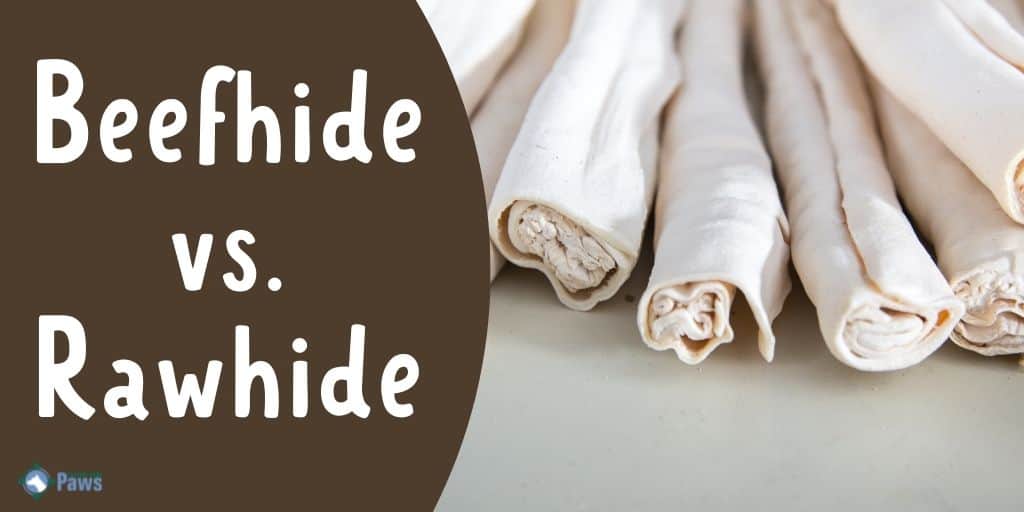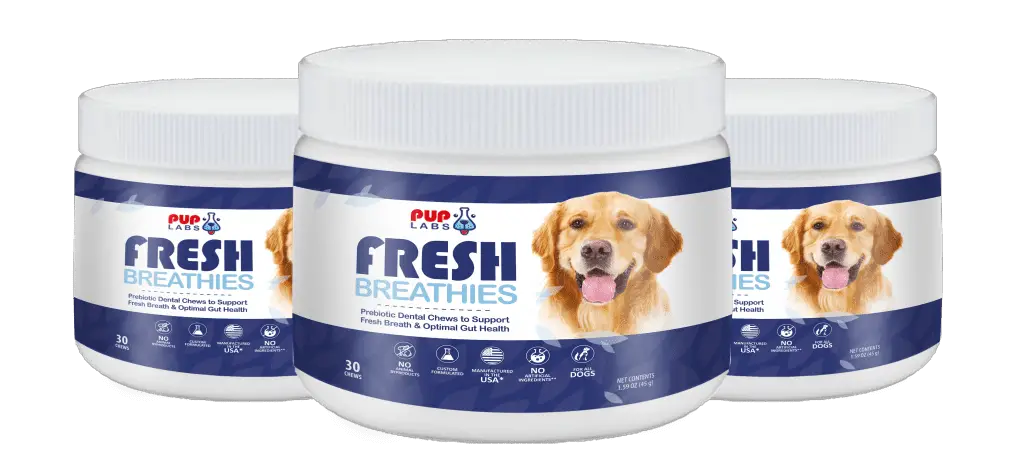We all want only the best for our canine pals, especially when it comes to the food they eat and what treats we give them.
When deciding what pet food or treats to get for your dog, many owners debate whether they should get treats made of beef hide or rawhide.
Such a decision can feel somewhat overwhelming, and it can be challenging to know what option is best for your dog.
Well, we’re here to help! Below is all the information you need to know about rawhide and beef hide.
Beefhide vs Rawhide Dog Chews
Is Beefhide the Same as Rawhide?
Yes, beefhide and rawhide are essentially the same thing! Both are made from animal hide, typically from cows, and are processed in a similar way to create a chewy treat for dogs.
The main difference is that beefhide is made from the hide of cows, while rawhide can be made from the hide of any animal, including cows, horses, and even deer.
Rawhide Chews
Rawhide is pretty much what it says on the tin!
It’s raw animal hide (or, in other words, animal skin) that has undergone processing to turn it into dog treats or other producs1.
Hides of cleft hoofed bovine livestock are used to make these types of treats, but the types most used are pork, beef, buffalo, and horse.
Treats made from rawhide usually come in strips, sheets or are turned into shapes such as braids.
Click here to learn how rawhides stack up against bully sticks!
Beef Hide Chews
What is beef hide? Beefhide is rawhide made from, as the name suggests, the same animal that provides beef: Cattle.
So, while rawhide can contain any, and sometimes multiple, hides, a beef hide is only ever made from cows.
It’s primarily made in the same way as rawhide and comes in similar shapes and sizes.
Is Beefhide Good For Dogs?
In moderation, beefhide chews can definitely be a tasty treat for your furry bestie.
Chewing on beefhide can provide some dental benefits and can be a fun activity for pups.
Just make sure to supervise your doggo while they chow down on beefhide and throw away any pieces that could be dangerous if swallowed.
And don’t forget to choose high-quality beefhide treats made from natural, untreated hide.
Otherwise, beefhide can be a pawsome treat for your doggo!
Pros and Cons of Rawhide Treats
The benefits and drawbacks of rawhide and beef hide are widely the same, and these are listed below.
Pros
Tasty Flavor
Dogs love rawhide chews as they are delicious.
We, humans, enjoy a tasty snack, so why shouldn’t our dogs be able to as well?
One difference between rawhide and beefhide is that it’s common for rawhide to contain flavorings to make them even more appealing, whereas beefhide often doesn’t need these added flavors.
Non-Destructive Chewing Outlet
I’m sure we’ve all discovered, to our dismay, how much our dogs enjoy chewing whatever they lay their eyes on.
This may be the couch, carpet, or even some of your favorite pairs of shoes!
One of the great benefits of rawhide chews is that they are a fantastic chewing outlet and terrific for keeping your dog occupied as they are treats that last for hours.
Good For Oral Health
Another benefit of rawhide dog treats is they can help promote good oral health for your dog.
This is because these treats often have certain enzymes that can aid in the breakdown of plaque and tartar to help keep your dog’s teeth clean.
This is highly beneficial to your dog’s dental health and can protect them from various issues.
However, it’s still important to brush your dog’s teeth every day.
Cons
Upset Stomach
One of the negatives of rawhide chews is that they can disrupt a dog’s stomach and digestive tract, leading to diarrhea and vomiting.
This wouldn’t be a very nice thing for your furry friend to have to go through (and not the most pleasant for you to clean up!).
Choking Hazard
Rawhides are supposed to be long-lasting dog chews and usually break down into small pieces.
However, if your dog has a firm bite, then bigger chunks can be broken off.
If your dog swallows large pieces of rawhide, this can create a choking and blockage risk2.
One of the most common issues reported by dog owners related to the treats is that large chunks broken off the chew have become lodged in their dog’s throat, with a trip to the vet needed as a result.
Rawhide swells when it comes into contact with too much water, meaning it can quickly become very soft.
This often makes the treat more of a choking hazard as it increases the likelihood of your dog swallowing it and the treat getting stuck in their esophagus or digestive tract.
Generally, your pet will eat the rawhide, and it will pass through their digestive system safely.
Therefore, you must stay with your dog and watch them while they are eating their rawhide treat.
That way, if a big chunk breaks off and your dog swallows it, you will be there ready to help them.
Can Fracture Teeth
While rawhide and beef hide treats are suitable for the dental health of your dog, there is the chance that the treats can sometimes be too hard and lead to damaged enamel or even fractured teeth.
This is something that would then need professional veterinary treatment.
Which is Better?

So, now let’s fully address that important rawhide vs. beef hide question.
As mentioned above, the benefits and drawbacks of the two are mainly the same, and so the choice of which one is best for your dog may be down to personal preference and which one your dog appears to enjoy the most.
However, one crucial difference that may be determining whether to go for rawhide or beefhide is that rawhide treats aren’t obligated to say what animal hide has been used to make them.
Therefore, if you want to know precisely what the treats you are giving your dog are made from, beefhide treats may be the best option for you.
Whichever type of rawhide treat you choose to give your dog, it is important to consider the cons mentioned above and understand the risk they pose.
However, listed below are some things you can do to reduce the likelihood of your furry friend experiencing any of these drawbacks.
Is Beefhide Safer Than Rawhide For Dogs?
It’s tough to say for sure, as both types of chew treats can pose potential risks if not used properly.
Both beefhide and rawhide can be harmful if a dog chews off and swallows large pieces, which can cause choking or blockages in the intestines.
It’s important to supervise your dog while they are chewing on either beefhide or rawhide, and to discard any pieces that become small enough to swallow or could cause a choking hazard.
That being said, some people may consider beefhide to be slightly safer than rawhide because it is made from the hide of beef cattle and is less likely to contain additives or preservatives.
Rawhide, on the other hand, can be made from the hide of any animal and may be treated with chemicals during the manufacturing process.
However, it’s important to note that high-quality, natural rawhide treats can also be safe for dogs if given in moderation and used properly.
Ultimately, the safety of both beefhide and rawhide will depend on the quality of the product and how it is used.
Always use caution and common sense when giving any chew treat to your dog.
How to Avoid Risk
1. Choose very large treats so your dog can’t swallow them
2. Take the treat away from your dog if it becomes soft, as this can make them more likely to swallow it, and therefore increase the risk of choking
3. Wash the treat before giving it to your dog to get rid of any bacteria
4. Remove and throw away treats that are, or have become, smaller than your dog’s mouth as this increases the chance of swallowing and choking
5. Only give the treat to your dog in moderation
6. Be near your dog while they are chewing the treat
Other Edible Chews
If, after this, you still feel concerned about your dog’s safety, then there are plenty of other chews out there for you to choose from instead!
Bully sticks, also known as pizzle sticks or beef pizzle, are completely digestible alternative dog chews considered to be one of the safest edible chew treats out there.
Bully sticks are made from the bull penis and are better for the digestive system, don’t pose such high obstruction risks as rawhide chews, and can still keep your dogs occupied for hours.
Fish skins are another great alternative. They still need chewing but have a far lower risk of cracking your pup’s teeth!




